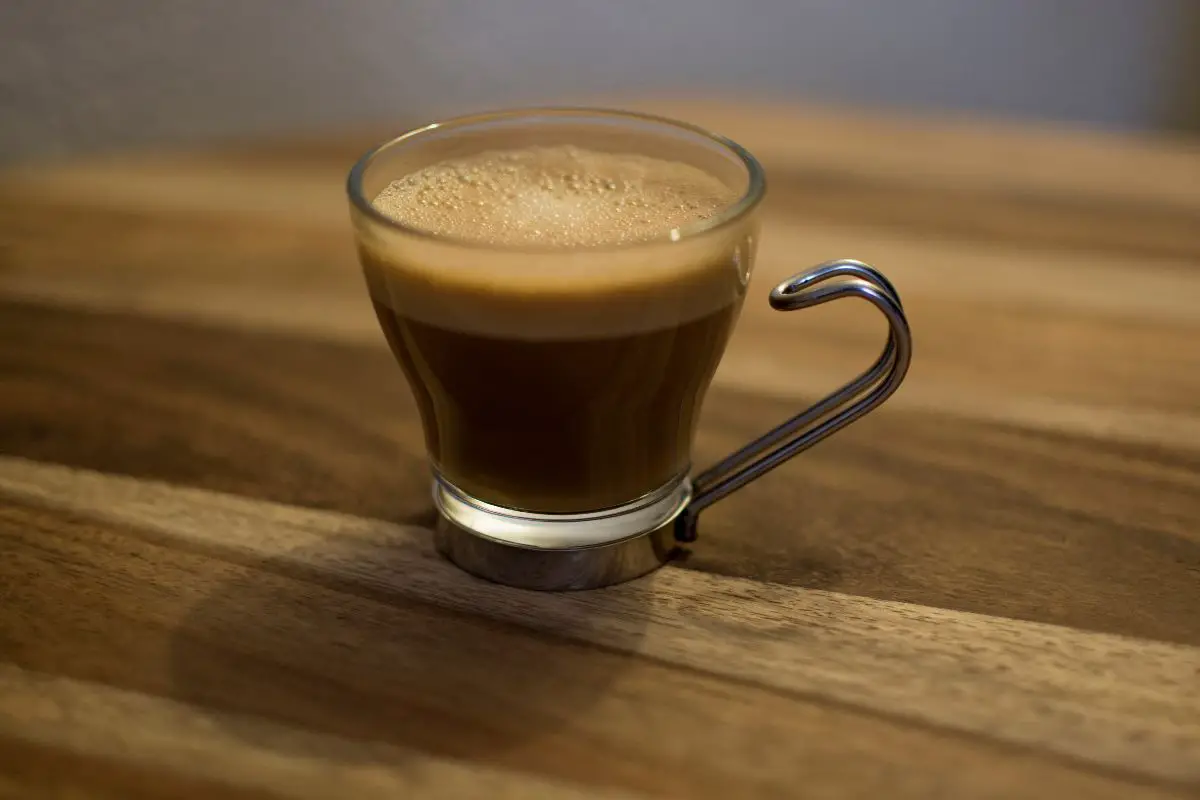In the realm of coffee, the choice between a cortado and a cappuccino can be likened to the age-old adage of ‘apples and oranges.’

While both beverages belong to the realm of espresso-based drinks, each possesses unique characteristics that set them apart.
In this comparative analysis, we will delve into the nuances of the cortado and the cappuccino, exploring the differences in milk ratio, texturing and foam, serving size, and presentation.
By examining these aspects, coffee enthusiasts and novices alike can make an informed decision when faced with the dilemma of choosing between these two beverages.
Whether one prefers a velvety mouthfeel with a balanced milk-to-espresso ratio, as offered by the cortado, or a frothy concoction topped with a delicate foam cap, synonymous with the cappuccino, this article aims to equip readers with the necessary knowledge to navigate the realm of coffee beverages with safety and confidence.
Key Takeaways
- Cortado and cappuccino are espresso-based drinks with unique characteristics.
- Cortado has a 1:1 milk-to-espresso ratio, while cappuccino follows a 1:1:1 milk-to-espresso ratio.
- Cortado has a smaller serving size (4-6 ounces), while cappuccino has a larger serving size (6-8 ounces).
- Cortado has a smooth and velvety milk texture, while cappuccino has a lighter and creamier texture with a thicker layer of foam on top.
What is a Cortado?
A cortado is a coffee beverage that consists of equal parts espresso and steamed milk, resulting in a visually distinct layered drink. It is typically served in a small glass to showcase its unique appearance. The name ‘cortado’ is derived from the Spanish word ‘cortar,’ which means ‘to cut,’ referring to the way the milk cuts the intensity of the espresso.
The preparation of a cortado requires a skilled barista who carefully balances the espresso and steamed milk to achieve the perfect ratio. The espresso provides a strong and robust flavor, while the steamed milk adds a smooth and creamy texture. This combination results in a well-balanced drink that is less intense than a pure espresso shot but more robust than a traditional milk-based coffee.
Although the cortado and the cappuccino share similarities, such as the use of espresso and steamed milk, they differ in terms of milk-to-espresso ratio and overall texture. While a cortado incorporates equal parts espresso and milk, a cappuccino typically follows a 1:1:1 ratio of espresso, steamed milk, and foam. Additionally, a cappuccino has a thicker layer of foam on top, giving it a lighter and airier texture compared to a cortado.
A cortado is a visually distinctive coffee beverage that combines equal parts espresso and steamed milk. Its balanced flavor and smooth texture make it a popular choice for coffee enthusiasts who desire a less intense coffee experience.
Transitioning to the subsequent section about cappuccino, it is important to understand the differences between these two beverages.
What is a Cappuccino?
The origins and history of the cappuccino can be traced back to Italy in the early 20th century. It is believed to have been named after the Capuchin friars, who wore brown hooded robes similar in color to the coffee’s light brown froth.
The cappuccino is traditionally made with equal parts espresso, steamed milk, and milk foam, creating a layered and visually appealing drink. Its flavor profile is characterized by a rich and bold espresso base, balanced with the creamy texture of the steamed milk and the lightness of the foam, resulting in a well-rounded and satisfying coffee experience.
The Origins and History of the Cappuccino
Originating in Italy, the cappuccino has a rich history that can be traced back to the 17th century. Initially, it was considered a beverage only consumed by the elite due to its association with the wealthy and upper class.
However, over time, the cappuccino broke through these barriers and gained popularity among the general population. This shift in perception can be attributed to the increasing accessibility of coffee and the rise of coffeehouses as social gathering places.
The cappuccino’s journey from exclusivity to widespread acceptance showcases its ability to adapt and become a beloved beverage enjoyed by people from all walks of life.
Moving forward, it is important to understand the ingredients and preparation of a cappuccino, as they play a crucial role in achieving its distinct taste and texture.
The Ingredients and Preparation of a Cappuccino
To fully appreciate the distinct taste and texture of a cappuccino, it is essential to delve into the meticulous selection and careful preparation of its ingredients. This process involves a harmonious blend of three key components: espresso, steamed milk, and milk foam.
- Espresso: The foundation of a cappuccino, espresso is a concentrated coffee extract obtained by forcing hot water through finely ground coffee beans. Its intense flavor and robust aroma provide the base for the drink.
- Steamed Milk: The addition of steamed milk creates a creamy and velvety texture, enhancing the overall mouthfeel. The milk is heated and frothed to a specific temperature, creating a smooth consistency.
- Milk Foam: The final touch, milk foam, adds a visually pleasing layer of froth on top of the cappuccino. It is created by introducing air into the steamed milk, resulting in a light and airy texture.
Understanding the meticulous process of selecting and preparing these ingredients contributes to the enjoyment and safety of a cappuccino.
Transitioning into the subsequent section about the flavor profile of a cappuccino, it is evident that its distinctive taste is a result of this careful craftsmanship.
The Flavor Profile of a Cappuccino
Crafted with precision and artistry, the flavor profile of a cappuccino is a symphony of rich, bold espresso, velvety steamed milk, and airy milk foam, each note harmonizing to create a sensory experience that dances on the palate.
The espresso forms the foundation of the flavor, with its intense and robust taste that provides a deep and complex base.
The steamed milk adds a smooth and creamy element, balancing the intensity of the espresso and imparting a subtle sweetness.
Finally, the milk foam crowns the cappuccino, contributing a light and airy texture that enhances the overall mouthfeel.
Together, these elements create a well-balanced beverage with a harmonious blend of flavors.
Transitioning into the subsequent section about differences in milk ratio, it becomes apparent that the varying proportions of milk to espresso play a significant role in shaping the flavor profile of both cortado and cappuccino.
Differences in Milk Ratio

The milk-to-espresso ratio is an important factor in determining the taste and texture of both cortado and cappuccino.
In a cortado, the milk-to-espresso ratio is typically equal, resulting in a balanced and smooth flavor.
On the other hand, a cappuccino has a higher milk-to-espresso ratio, creating a creamier and more frothy texture.
Understanding these differences in milk ratios can help coffee enthusiasts choose the drink that best suits their preferences.
The Milk-to-Espresso Ratio in a Cortado
One notable statistic is that the milk-to-espresso ratio in a cortado typically consists of equal parts, resulting in a harmonious balance of flavors that can evoke a sense of satisfaction in coffee enthusiasts. This ratio ensures that the espresso remains the star of the show, with the milk providing a creamy and velvety texture without overpowering the espresso’s bold and robust notes. The equal parts ratio also allows the flavors of the coffee to shine through, providing a rich and satisfying experience for those who appreciate the intricacies of a well-crafted cortado.
To further illustrate the milk-to-espresso ratio in a cortado, the following table compares the ratios in a cortado, a cappuccino, and a latte:
| Coffee Drink | Milk-to-Espresso Ratio |
|---|---|
| Cortado | 1:1 |
| Cappuccino | 1:2 |
| Latte | 1:3 |
From this table, it is evident that the cortado has the closest ratio to equal parts, highlighting its emphasis on balance and showcasing the espresso’s flavor profile. It is interesting to note that the milk-to-espresso ratio in a cappuccino differs, which will be explored in the subsequent section.
The Milk-to-Espresso Ratio in a Cappuccino
In the realm of coffee ratios, the milk-to-espresso ratio in a cappuccino is distinct from that of a cortado. A cappuccino typically consists of equal parts espresso, steamed milk, and milk foam, resulting in a balanced and creamy beverage.
The equal proportions of milk and espresso create a harmonious blend of flavors, allowing the richness of the espresso to be complemented by the velvety texture of the milk. This balanced ratio also ensures that the flavors of the espresso are not overpowered by the milk, providing a satisfying and enjoyable coffee experience.
Transitioning to the subsequent section about ‘texturing and foam,’ the milk foam in a cappuccino plays a crucial role in adding a layer of texture and enhancing the overall aesthetic appeal of the beverage.
Texturing and Foam
The milk texture in a cortado is characterized by its smooth and velvety consistency. It is steamed to a microfoam state, which results in a dense and creamy texture. This allows the milk to blend seamlessly with the espresso, creating a balanced and harmonious taste.
In contrast, the milk texture and foam in a cappuccino are distinctively different. The milk is steamed to create a thick and airy foam, which is then poured onto the espresso. This creates a layered effect, with the espresso at the bottom, followed by a layer of foam, and finally topped with a dusting of cocoa or cinnamon.
The foam adds a light and frothy element to the cappuccino, providing a contrast in texture to the rich espresso flavor.
Overall, the milk texture in a cortado and the milk texture and foam in a cappuccino contribute to the overall experience and taste of each drink. Understanding these differences allows coffee enthusiasts to appreciate the unique characteristics of each beverage and make informed choices based on their preferences.
The Milk Texture in a Cortado
To achieve the desired milk texture in a cortado, the steamed milk should be velvety and smooth, similar to that in a cappuccino. This can be achieved by following these steps:
- Proper temperature: The milk should be steamed to a temperature between 150°F and 155°F (65°C and 68°C). This ensures the milk is warmed enough without overheating, which can result in a burnt taste.
- Correct milk consistency: The milk should be steamed to create microfoam, consisting of tiny bubbles that give the milk a creamy texture. This can be achieved by positioning the steam wand just below the surface of the milk and slowly incorporating air.
- Steaming time: The milk should be steamed for around 20-30 seconds, depending on the volume being used. This allows for proper heating and creates the desired texture.
- Jug swirling: After steaming, gently swirl the milk jug to incorporate any remaining bubbles and create a smooth texture.
The milk texture and foam in a cappuccino also play a crucial role in the overall taste and experience.
The Milk Texture and Foam in a Cappuccino

A crucial aspect of a cappuccino is the milk texture and foam, as they significantly impact the overall taste and experience. Achieving the perfect milk texture in a cappuccino requires careful attention to details.
The milk should be steamed to a specific temperature, typically around 150°F, to create a velvety texture that enhances the coffee’s flavor. The milk should also be frothed to create a thick layer of foam on top of the espresso. This foam not only adds a visual appeal to the cappuccino but also provides a creamy and smooth mouthfeel.
The balance between the milk texture and foam is crucial, as too much foam can overpower the coffee flavor, while too little may result in a flat and unsatisfying drink. The milk texture and foam in a cappuccino significantly contribute to its overall quality and should be carefully crafted to ensure a delightful experience.
Moving on to the next section about serving size and presentation, the cappuccino’s milk texture and foam should be complemented by an appropriate serving size and visually appealing presentation.
Serving Size and Presentation
Comparing the serving sizes and presentation of cortado and cappuccino is like comparing a delicate brushstroke to a bold stroke of a paintbrush. While both beverages consist of espresso and milk, their proportions and presentation differ significantly.
- Cortado: The serving size of a cortado is typically smaller, ranging from 4 to 6 ounces. This smaller size allows for a higher concentration of espresso, resulting in a bolder flavor. The milk in a cortado is steamed, but the texture is velvety and smooth rather than frothy. It is often served in a small glass, showcasing the layered espresso and milk.
- Cappuccino: In contrast, a cappuccino is served in a larger cup, ranging from 6 to 8 ounces. The milk in a cappuccino is frothed, creating a thick layer of foam on top. This creates a lighter and creamier texture, balancing the boldness of the espresso. Cappuccinos are often presented with intricate latte art, adding to the aesthetic appeal.
When deciding between a cortado and a cappuccino, it is important to consider your preference for serving size and presentation. If you enjoy a bold and concentrated espresso flavor with a velvety texture, the cortado may be your ideal choice. On the other hand, if you prefer a balanced combination of espresso and frothed milk, along with a visually appealing presentation, the cappuccino may be more suitable for you.
How to Choose between a Cortado and a Cappuccino
When deciding between the cortado and cappuccino, one must carefully consider their personal preferences and desired sensory experience. Both beverages have distinct characteristics that can influence the choice.
The cortado is a coffee drink that originated in Spain and is characterized by its equal parts of espresso and warm milk. It is typically served in a small glass, allowing the layers of espresso and milk to be visible. The cortado offers a balanced flavor profile, with the espresso providing a strong and robust taste while the milk adds a smooth and creamy texture. This drink is ideal for those who prefer a milder coffee taste with a hint of sweetness.
On the other hand, the cappuccino is an Italian classic consisting of equal parts of espresso, steamed milk, and milk foam. It is traditionally served in a larger cup, allowing for a more generous serving size. The cappuccino offers a rich and bold flavor, with the espresso providing a strong and intense taste, balanced by the creamy texture of the steamed milk and foam. This drink is perfect for those who enjoy a stronger coffee flavor with a velvety mouthfeel.
Ultimately, the choice between a cortado and cappuccino depends on personal preferences. If one prefers a milder and sweeter coffee experience, the cortado would be the ideal choice. However, for those who crave a bolder and more robust flavor, the cappuccino would be the better option. It is important to consider these factors when making a decision to ensure a satisfying and enjoyable sensory experience.
Frequently Asked Questions
Are cortado and cappuccino the same thing?
Cortado and cappuccino are not the same thing. While both are espresso-based drinks, they differ in terms of milk quantity and texture. Cortado has less milk and a thicker texture, while cappuccino has more milk and a frothier consistency.
Can I customize the milk ratio in a cortado or cappuccino?
Yes, it is possible to customize the milk ratio in both cortado and cappuccino. The milk ratio can be adjusted according to personal preference, allowing for variations in the strength and creaminess of the coffee.
Is the texture of milk in a cortado different from that in a cappuccino?
The texture of the milk in a cortado differs from that in a cappuccino. While a cortado has a velvety-smooth texture, a cappuccino has a frothy and creamy texture due to the varying milk-to-espresso ratios used.
Are cortados and cappuccinos typically served in the same size cups?
Cortados and cappuccinos are typically served in different size cups. While the exact cup size can vary, cortados are commonly served in smaller cups, while cappuccinos are typically served in larger cups to accommodate the foam and milk.
What factors should I consider when deciding between a cortado and a cappuccino?
When deciding between a cortado and a cappuccino, factors to consider include the desired coffee-to-milk ratio, strength of flavor, texture, and overall taste preferences. These factors will help determine the most suitable choice for an individual.
Conclusion
In conclusion, the comparison between a Cortado and a Cappuccino reveals distinct differences in milk ratio, texturing and foam, serving size, and presentation.
The Cortado features a higher coffee-to-milk ratio with minimal foam, resulting in a stronger coffee flavor.
In contrast, the Cappuccino has a balanced milk-to-coffee ratio with frothy foam, offering a creamier and milder taste.
When choosing between the two, preferences for taste, strength, and visual appeal should be considered.
Ultimately, understanding these differences allows coffee enthusiasts to make an informed decision based on their individual preferences.
Related articles: